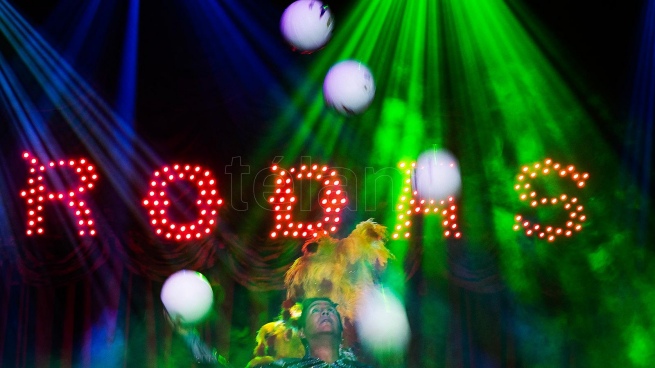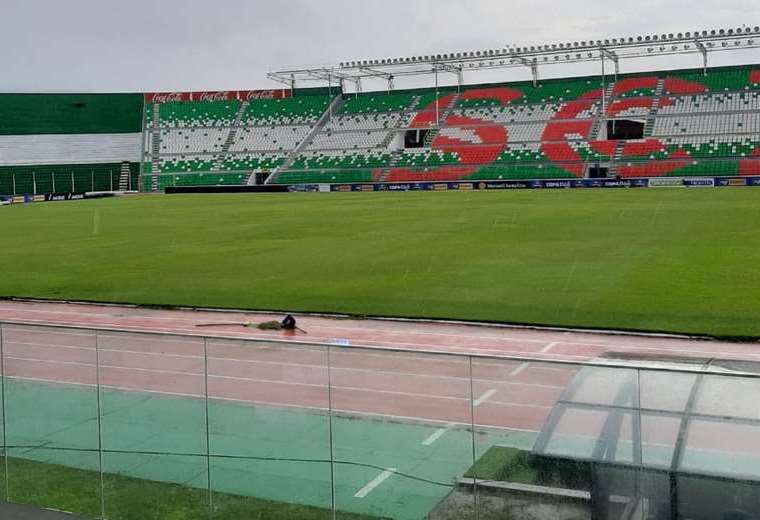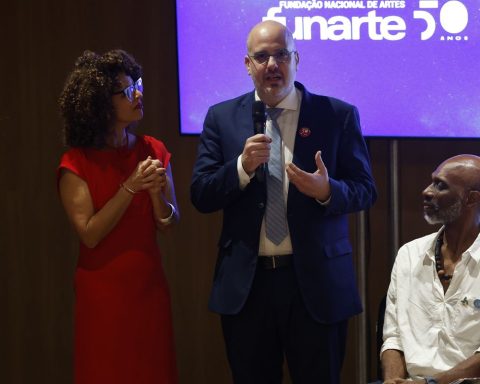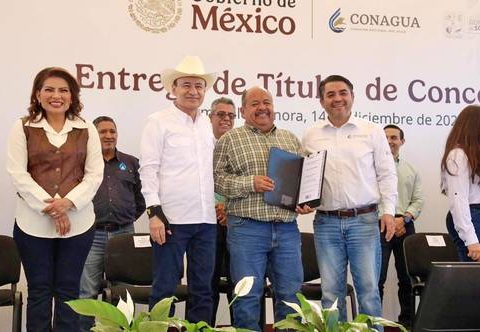El Rodas, the largest and oldest of the Argentine circuses that are still in operation, is turning 40 this 2022 with the magic intact and the strength of having survived a thousand and one challenges, from hyperinflation to the prohibition of numbers with animals. , from being reduced to a single seized tent inside a closed park to being forced to stop due to the coronavirus pandemic.
“The circus persists because it is the only live show that moves to your city, to your neighborhood and stays for months. Imagine when we arrived in Jujuy, seeing all this display on a piece of land that people were used to seeing as vacant. Going through and seeing this small armed neighborhood makes you curious, a need to really see what is inside here,” Marcelo Lanza, general producer of Circo Rodas, told Télam.
“And then we start the performances and the word of mouth recommendations begin because what we give as a show is more than what you pay for admission, and then what was going to be six weeks becomes eight or 14, depending on how we go” , he added.

In short, the circus continues to attract the public because its magic is not restricted to the stage, but is inscribed in the nomadic way of life of the circus family and is even present as soon as one enters that enormous and colorful canvas theater, which It is the main tent.
“If you do this same show inside a club, a gym or Luna Park, it does not generate the same thing for you; the tent is an environment that predisposes you differently and you enter a climate that makes you value twice what is above the stage,” he said.
“The circus persists because it is the only live show that moves to your city, to your neighborhood and stays for months. Imagine when we arrived in Jujuy, seeing all this display on a piece of land that people were used to seeing as vacant. Going by and seeing this little armed neighborhood makes you curious, a need to really see what’s in here.”Marcelo Lanza, general producer of the Rodas Circus
Stationed at Crovara and General Paz, in the Buenos Aires town of La Tablada, since the end of June, Circo Rodas offers performances from Thursday to Sunday of a show that includes the famous balloon of death, dancing waters, aerial acrobats, jugglers, clowns , knife throwers, flying motorcyclists and choreography with 20 dancers on stage.
Total, 261 people live from and in the circuscounting the 147 relatives and the 114 employees, among whom there are two trapeze artists who come from working with Cirque du Soleil and the Chilean clowns Cachipuchi and Chuchocafather and son in real life.
“I only came for three months to work at Rodas and I’ve been there for six years, the truth is that I’m delighted because in each function we receive immense affection and adult people come with many memories who tell you ‘I came when I was little,'” he assured Télam Cachipuchi, a 19-year-old who is “the fifth generation of the circus on my mother’s side and the sixth on my father’s side.”

Another is the case of prima ballerina Cintia Sereinwho joined the circus five years ago from “the stable life”.
“It is a little difficult at first to adapt (to the nomadic life of the circus) and for me the most difficult thing is to be away from affections; this being four months away and not seeing loved ones or seeing them by video call. But taking that out is a very nice experience that is giving me the opportunity to get to know beautiful places in the country,” said Serein, who is the daughter of the late singer “Pocho” La Pantera and the vedette Norma Serein.
Love for the profession and a nomadic lifestyle
A strict physical care, boundless love for the profession, the cult of a nomadic lifestyle and the ability to deploy an unbeatable formula of humor, show and skills are some of the characteristics of those who dedicate themselves to the circus art, according to the general producer of the Rodas Circus, Marcelo Lanza.
“I would define it as one of the healthiest shows that exist in the medium because the artists cannot have a drop of alcohol or anything because not only is their life at risk but that of their colleagues,” he said.
“On the other hand, it is not something that is done for money because if we learned something with the pandemic, it is that we can work for something else and even earn more, but the day the circus opened, we all came back,” he added.
And this despite what this work implies, because “We not only work here but we live together in the circus”which makes up a mini-neighborhood of families whose school-age children move from school to the beat of the circus tours.
“There is a law that protects us and that indicates that every time the circus arrives at a place, they have to give us the necessary vacancies in the schools and we make use of that. That is our life and that of our children who are already accustomed, and that when we are going to move they are already thinking about who their new friends are going to be,” he confided.
Lanza stressed that the circus is a growing culture because “until 20 years ago, everything you saw from the circus was inside a circus” while “now there are circus schools everywhere” and “any play includes circus numbers that did not have it before”.
“The circus is growing day by day in silence and anonymously, because suddenly it is easier to put on a show with someone in the media who cuts a thousand tickets just by telling three or four gossip about some famous person, than to put on a show with gentlemen artists whose name nobody knows because they are not in a marquee nor do they demand that: the only thing they ask is that the public value it through their applause”, he said.
The Rhodes It was created by Miguel Ángel Percudani who in July 1982 fulfilled his dream of having his circus, after having learned the business working with his uncle and a first experience on a smaller scale -but also his own-, the Imperial Circus.
During its first stage with this owner, the circus experienced moments of glory with more than 200 employees and great figures of the show on its stages such as Pipo Pescador, Carozo y Narizota, Flavia Palmiero, El Pato Carret, Raúl Portal, El mago Emanuel, Bicho Gómez and Flavio Mendoza, among others; but also of anxiety and uncertainty such as hyperinflation.
“There came a time when you filled the circus but then the electricity ticket arrived and you couldn’t pay it but you couldn’t increase the ticket much either because people didn’t come to you,” Lanza said.
Under more favorable winds, Rodas was a pioneer in transforming the traditional circus into a true music hall with more than 30 professional dancers and a superb wardrobe that was showcased throughout the country.
With the next great economic crisis, that of the late ’90s and early 2000s, the Rodas almost disappeared forever after spending months in a closed Sarmiento Park and with its tent seized.
Without the possibility of working, the employees were leaving the circus until in mid-1999 there were only a couple of them living in the place, according to the press at the time.
“The circus was closed for almost a year and a half and there it was acquired by the current owner, Jorge Ribeiro Soares, who took about eight more months to prepare a decent structure for the return, because the only thing left of the Rodas circus is the name” Spear evoked.
Recovered its former splendor, in 2004 it had to get rid of the pigeons and rabbits, by virtue of Law 1,446 of the City of Buenos Aires.
Nine years earlier, Rodas had already given the Buenos Aires zoo its famous elephant Mara that in 2020 was transferred to a sanctuary in Brazil.

In 2020, isolation due to the pandemic found the circus ready to premiere in the Buenos Aires town of Berissowhere it remained a year without being able to open, with its workers using the trucks to ship freight and selling popcorn, dolls and cotton candy around the neighborhoods to survive.
When they were enabled to reopen on March 26, 2021 in Rosario, they had to close a month later due to the second wave of Covid-19 and wait until July 13 to resume the show.
Today the circus offers a completely renewed showwith a staff of artists in constant change due to the quality of their performances that make them attractive for circuses abroad.
The reinvention of the circus, devoid of “freaks”, animals and child labor
The circus show has undergone profound changes in recent decades to adapt to new forms of social sensitivity and its regulatory frameworks; and the history of the Rodas circus allows us to follow the traces of some of these transformations, such as the prohibition of acts with animals or child labor up to 16 years of age.
A first change registered in the middle of the 20th century that the Rhodes did not go through because it was born in 1982, when it was already totally exiled, was that of the attractions called “circus phenomena”.
The general producer of the Rhodes Circus Marcelo Lanza explained to Télam that the first modern circuses began in the 19th century “with the ‘phenomenons’ and their owners went around the world looking for a bearded woman, an elephant man” or short people.
“The attraction of this type that cut the most tickets was The Siamese of the Barnun circus in the United States and in fact the twins attached today are called that because they had been brought from Siam” (now Thailand), he said.
The change that did fully impact the history of Rhodes was the ban on animal shows
“This circus was emblematic because of the elephant Mara that we brought when she was 11 years old and that 21 years ago we donated to the Buenos Aires Zoo where she was until two years ago when they took her to a sanctuary in Brazil,” he said.
But the Rhodes was not noted for the animals. “We had a white tiger in magic, the elephant, a very clever chimpanzee who drank coffee and rode a bike or motorcycle, pigeons and cats, which are now prohibited. But there were circuses that were 80% animal numbers, for them it was much worse,” he said.
“Today you can’t even take a rabbit out of a magician’s hat because they’re going to shut you down,” he said.
Another important regulatory change was the inclusion in the Penal Code of article 148 bis that punishes with prison anyone who uses the labor of a boy or girl under 16 years of age, by virtue of Law 26,390 of 2008.
“In other countries you can, but small children are not allowed on stage here. We had a number of a Russian who did a handstand with his son, as a hanger, and who played the sax while he did the number with his father. “Lance said.
But the most important ongoing social revolution is the feminist one, which according to Lanza is not having a major impact on Rodas where “there have always been the same number of men and women among the artists and the clowns make a very light humor”, devoid of doubles macho senses.
The first dancer Cintia Serein considers that the circus is “very inclusive” of female artists who do not have space in other shows.
“In the artistic environment in Argentina, when it comes to dance, it seems that we women have an expiration date, you passed 30 and everything fell out and you are no longer good. And the circus always had a lot of this that no matter the age, as long as your skill is still standing, it gives you room to work,” he said.


















